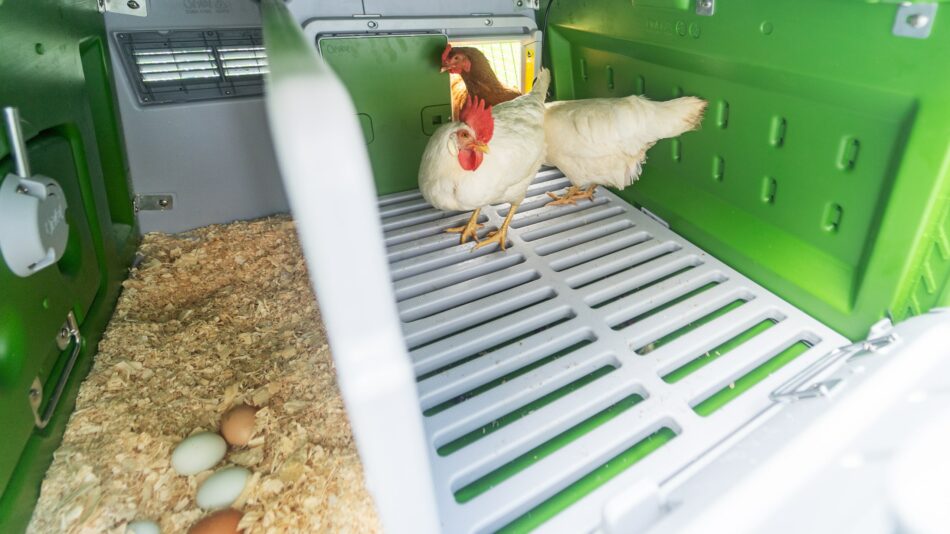How do chickens lay eggs?
How do chickens lay eggs? Chicken keepers and egg eaters alike often ask this question. This fascinating process is complex, but occurs daily within laying hens. Take an in-depth look at the egg-laying process from start to finish – it’ll make you give your laying hens a round of applause.
Egg-laying frequency
Eggs are amazing feats of nature. Not only are they considered a superfood due to their nutritional value, but laying hens can produce over 300 eggs per year. A small flock of laying hens can easily provide your family with fresh eggs.
Ovulation takes place every 24-36 hours for most laying breeds of chickens. This results in an egg being laid roughly every day and a half. Some laying breeds can lay an egg every day or more. The world record number of chicken eggs laid in a year is 371 eggs in 364 days, set by a White Leghorn hen in 1979.
The process of laying an egg
Chickens ovulate like other animals, but instead of eggs the size of small cells being released, hens lay the nutritious, tangible orbs that we enjoy for breakfast. The process of laying an egg takes around 24 hours, and hens as young as 18 weeks old can begin laying. We’ll break down each step of the egg-producing process.
Step 1: it starts with light
Egg laying actually starts with your chickens’ eyes. Sunlight enters through a hen’s eye and activates a photosensitive receptor called the pineal gland – located behind the eye. Once the pineal gland is stimulated, it triggers a string of events that releases an egg, or oocyte, from the hen’s ovary. This light sensitivity is one of the reasons chickens lay fewer eggs in the winter.
Step 2: formation of the yolk
Hens are born with two ovaries, but the right ovary becomes dormant after a female chick hatches. The left ovary is the one that will produce eggs throughout a hen’s lifetime and contains thousands of ovum, which will become future eggs.
If you were to look inside a chicken, these undeveloped ova can be seen at the start of the spine. When the chicken is old enough to start laying, some of these ova begin to mature into what will later become the yolk. At this stage, the ova are separated and contained within their own follicles, but when one is ready to move on it releases its follicle and moves out of the ovary and down the reproductive tract, the oviduct.
This process, called ovulation, occurs approximately every 25 hours, and normally starts again about an hour after the previous egg has been laid.
Step 3: egg white surrounds the yolk
Up until this point in ovulation, all chicken eggs are unfertilized. Hens can lay eggs with or without the presence of a rooster, but they can be fertilized if you keep a cockerel in your flock. Fertilized eggs are edible, as long as you collect the eggs daily.
Via the infundibulum, the yolk enters the oviduct, and it is here that the egg is fertilized if a rooster has courted your hen. You might have noticed that egg yolks have a small, white spot on them. This is the blastodisc, the single female cell that together with the sperm will develop into an embryo through cell division.
The journey of the egg is, however, the same regardless of whether it’s been fertilized or not. The yolk travels through the magnum and isthmus parts of the oviduct, and this is where the egg white (also called the albumen) is created. It works as a thin membrane around the yolk that holds everything together. The chalazae, two spiral bands of tissue, make sure that the yolk is evenly positioned within the albumen, and the whole thing starts looking like an egg – without its hard covering.
Step 4: the shell is formed around the egg
The egg receives its shell in the uterus, through the shell gland. It takes roughly 20 hours to produce the shell, and is the most time-consuming part of the process. Before the egg moves on for the last time, the outermost layer, known as the bloom or cuticle, is formed to create an antimicrobial layer around the shell. When the egg is ready, the shell gland pushes the egg out of the oviduct and into the cloaca or vent, the part where the reproductive and excretory tracts meet. Hens excrete all eliminations through the vent, but the hen’s uterine lining actually wraps around the egg until it is completely free from the hen’s body – keeping it nice and clean.
Egg laying the Omlet way
And there you have it – the amazing journey an egg makes before being laid by a hen. Our chicken coops offer your hens a safe and comfortable place to deposit the fruits of their labour. And to store those labours of love, try our Egg Skelter, which will proudly display your hens’ amazing, natural works of edible art.
This entry was posted in Chickens

